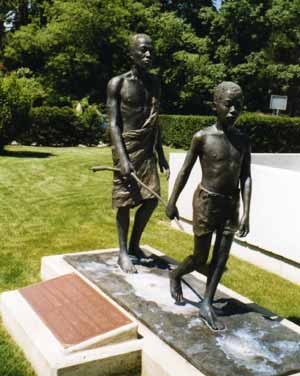 If you have been to the headquarters of the World Health Organisation, you will notice this stature right in front of the main building. It represents the efforts made to control one of a disease many in the West might never have heard about called River Blindness.
If you have been to the headquarters of the World Health Organisation, you will notice this stature right in front of the main building. It represents the efforts made to control one of a disease many in the West might never have heard about called River Blindness.
The African Programme for Onchocerciasis Control (APOC) is heralded by many as one of Africa’s most successful public health programmes.
One of the keys to its success is that it by-passes government!, delivering the once-a-year treatment; Ivermectin through community volunteers directly to the affected populations. This approach called Community Directed Treatment is now being replicated for Vitamin A, de worming medicines, insecticide-treated bed nets and potentially several other public health interventions. The programme itself was innovative in being the first that negotiated an unprecedented pledge from the manufacturer of Ivermectin; Merck to provide an unlimited supply of the drug, for all who needed it, for as long as it takes.
The current director of the African Programme for Onchocerciasis Control (APOC) is a simple Nigerian lady; Dr Uche Amazigo. The article linked here describes her as “The sc ientist with a large heart for Africa’s poor“. I recently had the opportunity of watching Dr Amazigo at work, steering the WHO bureaucracy, negotiating with partners and funders, motivating her staff and managing the large network of colleagues in several countries on whom she depends on make APOC succeed.
ientist with a large heart for Africa’s poor“. I recently had the opportunity of watching Dr Amazigo at work, steering the WHO bureaucracy, negotiating with partners and funders, motivating her staff and managing the large network of colleagues in several countries on whom she depends on make APOC succeed.
River Blindness….is the common name for the most important clinical syndrome caused by onchocerchiasis. It is the world’s second leading infectious cause of blindness. It is caused by Onchocerca volvulus, a small worm that breeds in fast-flowing rivers and can live for up to fifteen years in the human body. It is transmitted to people through the bite of a black fly. The worms spread throughout the body, and when they die, they cause intense itching and a strong immune system response that can destroy the eye. About 18 million people are currently thought to infected with this; approximately 300,000 have been permanently blinded.
As with many other illnesses, we have a simple treatment that is entirely free to the patient. The challenge is to deliver it to them for the 15 consecutive years required for an individual to clear the disease. As with other diseases where a “simple” treatment is available there are obvious pressures to push for eradication. Many believe that following the efforts of the Carter Center and its partners, Guinea worm is on the verge of eradication. If that works…who knows….will Oncho be next? Others think that the “cross” of the target “eradication” is too heavy to carry, as anything less will be perceived as failure.
Watching Dr Amazigo work over a week….I cannot help but think of Chinua Achebe’s epic book; The Trouble with Nigeria“. On the first page, Achebe says bluntly: “the Nigerian problem is the unwillingness or inability of its leaders to rise to the responsibility and to the challenge of personal example which are the hallmarks of true leadership.
I think not….I think that the real tragedy with Nigeria is the paucity of opportunity for real leaders to emerge in our political space, while Nigerians provide the leadership we so dearly miss at home… in every ither corner of the world.
If only Nigerian children will read about people like Dr Amazigo..if only….
Never doubt that a small group of thoughtful committed people can change the world; indeed it is the only thing that ever has…Margaret Mead



thank you so much for this post…
…nice way to start my day…
http://www.pbs.org/wgbh/rxforsurvival/series/champions/uche_amazigo.html
Her story just motivated to start my MPH….THIS SUMMER..BY GOD’S GRACE….AMEN…
Nice Post. Thanks For Sharing.